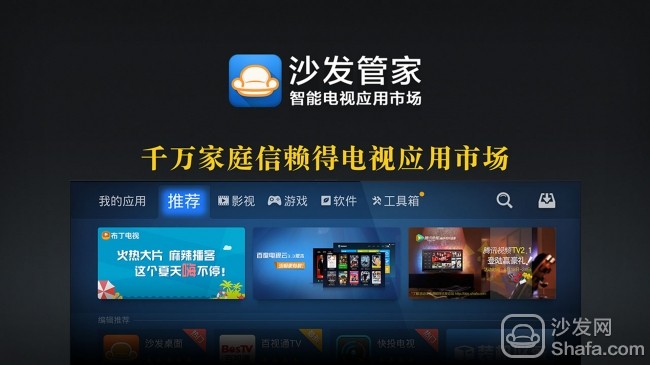
In the United States, more and more people are switching from traditional cable and satellite television to Internet TV. Internet TV has a lot of momentum but it has not yet become mainstream. Why does this happen when consumers are ready to embrace it and the relevant technical coefficients are in place? The technology blog Re/code recently released an article by Daniel Leff, the founder of the video industry fund Luminari Capital, to discuss five major obstacles to the widespread adoption of Internet TV.
The following is the main content of the article:
The news that television networks such as HBO and CBS will begin to provide their programming on the Internet has attracted widespread attention. However, in reality, more than 100 million U.S. households still prefer cable television or satellite antenna television services.
There are indeed millions of other consumers who have stopped subscribing to cable TV and are turning to Internet TV - whether it's free content on YouTube or paid subscriptions such as Netflix. In addition, the television content will be transferred to the Internet sooner or later.
People who are closely watching the evolution of online TV are certainly not unfamiliar with the hottest word in the television field of the OTT (overthetop). The word OTT originated from the first major network television distribution based on set-top boxes. Today, it is a term used to refer to the provision of video content over the Internet rather than traditional television systems. In the process of television networking, you will certainly hear this word.
Given that millions of consumers are ready to embrace Internet TV, and relevant technical support is already in place, why hasn't Internet TV become mainstream? This may be because there are still some major development obstacles, including the following 5 points:
1. If most pay TV content will be provided through various websites or services, does that mean that TV subscriptions will come to an end?
The costly cable/satellite multi-channel package (bundle) seems likely to disappear. If so, how can "sofa surfers" and mobile audiences easily get unbundled premium channel and premiere content without having to separately purchase services from various providers?
The answer may be the rise of "micro-packages." As the name implies, they refer to the shortened version of traditional cable television products, which are closer to consumers' personal preferences.
Mainstream companies such as Sony, DishNetwork, and Verizon are all negotiating digital streaming media for micro-packages consisting of several premium channels, which may solve the above problems. There are other startups that are also working to provide this solution.
It should be pointed out that any company that offers such micro-packages must be clear about how to develop scalable and profitable businesses. This is not easy. In addition, established companies offering such new packages will need to pay attention to the economic structure that they originally established with industry partners.
2. Will sports fans be satisfied on the Internet?
At present, it can be said that the major sports league programs are the glue of traditional cable TV packages. This situation will not change in the short term. Most of the live sports rights in the United States are in the hands of established companies, and the contract will not expire until 2020 or even later.
However, sports leagues and rights-holders have not been able to curb the tide of Internet innovation. Many mainstream competitions have been put online through paid packages such as MLB.tv and NBALeaguePass. At the same time, some sports and entertainment alliances have launched comprehensive OTT products such as WWE (WWENetwork).
For many sports fans, the comprehensive cable TV sports experience also includes the essence of the tournament and the talk show that is currently bundled with the broadcast rights. These programs are relatively limited on the Internet. Therefore, true TV sports fans (and their families) will not be willing to embrace OTT sports before OTT Sports has an equally great experience.
The X factor here includes current OTT giants such as Netflix, Amazon, Hulu and YouTube. If Internet platforms and technology platforms with strong financial resources decide to force all mainstream sports competitions to be fully online, then they will spend huge sums of money to purchase broadcasting rights and promote all of this.
3. How do viewers get local news on OTT service? Or broadly, network-based network model what circumstances would happen?
This is a tricky question, a question that is not yet easy to answer. The mainstream television stations in the United States belong to the television network, in part because they provide content through local simulcast television stations distributed throughout the United States - a legacy of the era of wireless television transmission. If local consumers can access local news and non-news content and then open OTT services, what is the use of local simulcast stations? Does this mean that local television news programs are just as extinct as local news?
Local advertising revenues and rebroadcasting fees from cable TV operators are the lifeline of local simulcast TV stations. The local TV advertising market is still vibrant, which means that those TV stations can also fill up the income. Local news may shift to new wireless TV industry projects such as TabletTV from MotiveTelevision, while some local news content may fall under CBSAllAccess's newly announced emerging network OTT service such as CBS.
Broadcast costs are another matter. However, as the number of subscriptions to cable television continues to decline, these costs will face downward pressure, further weakening local simulcast TV stations.
4. Why haven't Google and YouTube ruled this market yet?
YouTube is the world’s largest online video site and has more than 1 billion users, and 40% of them have already switched to mobile to watch some content. This made YouTube quietly leading the OTT field, especially considering that it was backed by Google with a market value of 370 billion U.S. dollars and a cash reserve of 62 billion U.S. dollars. They have the capital to do whatever they want, but so far they haven't actually displayed much of their edge.
This situation is likely to change. The industry is rumored that YouTube plans to launch an own advanced subscription service. It will also promote the service through video production.
YouTube has also spawned a new generation of content producers, connecting them through advertising-supported multi-channel networks (MCNs) to build a large audience. YouTube has multiple relationships with these companies: investment, partnership, content production subsidies, and so on.
5. Do emerging OTT forces and established video companies really understand the needs of consumers?
Consumers want choice, convenience, outstanding experiences and value. With HBO and CBS successively announcing the provision of content on the Internet, established companies have accused OTT services, and to remain competitive, they must think more rigorously about consumer demand.
The television sector may be like the Wild West for the time being, because no industry-level cooperation is expected. For consumers, the purchase of Netflix, Hulu, Amazon, and HBO services and other premium channel content is unbearable, and this does not solve two of the above problems. Consumers cannot buy at reasonable prices. Excellent experience. Consumers may not have bought several subscription services for a monthly subscription fee of US$9.99 and they would like to switch back to cable TV packages.
The next generation of "super aggregators" may have the opportunity to repackage all of the individual premium channels into extraordinary value experiences.
There is no clear leader in this area, but one such company may emerge in the future: providing beautiful program guides and user interfaces, rich variety of premium content and long tail content, and an easy and convenient experience for TV viewers. There are currently some exciting startup companies that are focused on this mission, including Pluto.tv and Roku.
The future of OTT is ready, but until these and other urgent issues are resolved, this prediction is still uncertain. But one thing is certain: The process of transition from cable and satellite television to Internet TV will involve enormous economic benefits.
Recommended installation sofa butler Download: http://app.shafa.com/
